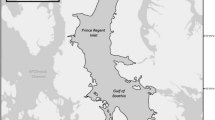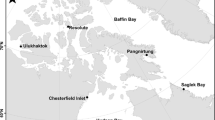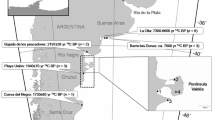Abstract
Recent influxes of warm Atlantic water into the fjords of west Spitsbergen have led to concomitant influx of more temperate and boreal fish species. The changes in the water masses within the fjords naturally affect all trophic levels of the sympagic, benthic, and pelagic food chains in the area. The most abundant marine mammal species in the fjords of west Spitsbergen is the ringed seal (Pusa hispida), which feeds, breeds, and moults in this area. In this study, we used isotopic data from whiskers of two cohorts of adult ringed seals (sampled in 1990 and 2013) to determine whether signals of ecosystem changes were detectable in this top marine predator. Acknowledging the limitations to our understanding of whisker growth in phocid seals, we interpreted the isotopic data from whiskers under two alternate hypotheses of whisker replacement dynamics and the dietary periods that might be represented. Even under the most conservative hypothesis, it is clear from our data that changes in the marine food web of the west Spitsbergen coast have occurred over the last 20 years, and that these are detectable in the isotopes incorporated into higher trophic predators. Concluding which aspect of the food web has been modified is complicated by a lack of recent ringed seal dietary studies, a knowledge gap that should be prioritised as the climate continues to change.



Similar content being viewed by others
References
Beltran RS, Sadou MC, Condit R et al (2015) Fine-scale whisker growth measurements can reveal temporal foraging patterns from stable isotope signatures. Mar Ecol Prog Ser 523:243–253. doi:10.3354/meps11176
Berge J, Heggland K, Lønne OJ et al (2015) First records of Atlantic mackerel (Scomber scombrus) from the Svalbard archipelago, Norway, with possible explanations for the extension of its distribution. Arctic 68:54–61. doi:10.14430/arctic4455
Blanchet MA, Lydersen C, Ims RA, Kovacs KM (2015) Seasonal, oceanographic and atmospheric drivers of diving behaviour in a temperate seal species living in the high arctic. PLoS ONE 10:e0132686. doi:10.1371/journal.pone.0132686
Cherel Y, Kernaleguen L, Richard P, Guinet C (2009) Whisker isotopic signature depicts migration patterns and multi-year intra- and inter-individual foraging strategies in fur seals. Biol Lett 5:830–832. doi:10.1098/rsbl.2009.0552
Comiso JC, Parkinson CL, Gersten R, Stock L (2008) Accelerated decline in the Arctic sea ice cover. Geophys Res Lett 35:1–6. doi:10.1029/2007GL031972
Cottier F, Tverberg V, Inall M et al (2005) Water mass modification in an Arctic fjord through cross-shelf exchange: The seasonal hydrography of Kongsfjorden, Svalbard. J Geophys Res 110:1–18. doi:10.1029/2004JC002757
Crawford K, McDonald RA, Bearhop S (2008) Application of stable isotope techniques to the ecology of mammals. Mamm Rev 38:87–107. doi:10.1111/j.1365-2907.2008.00120.x
Dalpadado P, Hop H, Rønning J et al (2016) Distribution and abundance of euphausiids and pelagic amphipods in Kongsfjorden, Isfjorden and Rijpfjorden (Svalbard) and changes in their relative importance as key prey in a warming marine ecosystem. Polar Biol 39:1765–1784. doi:10.1007/s00300-015-1874-x
Fleischer D, Schaber M, Piepenburg D (2007) Atlantic snake pipefish (Entelurus aequoreus) extends its northward distribution range to Svalbard (Arctic Ocean). Polar Biol 30:1359–1362. doi:10.1007/s00300-007-0322-y
Fossheim M, Primicerio R, Johannesen E et al (2015) Recent warming leads to a rapid borealization of fish communities in the Arctic. Nat Clim Change 5:1–6. doi:10.1038/nclimate2647
Fraley C, Raftery AE (2007) Bayesian regularization for normal mixture estimation and model-based clustering. J Classif 24:155–181. doi:10.1007/s00357-007-0004-5
Gilg O, Kovacs KM, Aars J et al (2012) Climate change and the ecology and evolution of Arctic. Ann N Y Acad Sci 1249:166–190. doi:10.1111/j.1749-6632.2011.06412.x
Gjertz I, Lydersen C (1986) The Ringed Seal (Phoca hispida) spring diet in nortwestern Spitsbergen, Svalbard. Polar Res 4:53–56. doi:10.3402/polar.v4i1.6919
Gluchowska M, Kwasniewski S, Prominska A et al (2016) Zooplankton in Svalbard fjords on the Atlantic–Arctic boundary. Polar Biol 39:1785–1802
Greaves DK, Hammill MO, Eddington JD, et al (2004) Growth rate and shedding of vibrissae in the gray seal, Halichoerus grypus: a cautionary note for stable isotope diet analysis. Mar Mamm Sci 20:296–304. doi:10.1111/J.1748-7692.2004.Tb01158.X
Hall-Aspland SA, Rogers TL, Canfield RB (2005) Stable carbon and nitrogen isotope analysis reveals seasonal variation in the diet of leopard seals. Mar Ecol Prog Ser 305:249–259. doi:10.3354/meps305249
Hamilton CD, Lydersen C, Ims RA, Kovacs KM (2016) Coastal habitat use by ringed seals Pusa hispida following a regional sea-ice collapse: importance of glacial refugia in a changing Arctic. Mar Ecol Prog Ser 545:261–277. doi:10.3354/meps11598
Hirons AC, Schell DM, St. Aubin DJ (2001) Growth rates of vibrissae of harbor seals (Phoca vitulina) and Steller sea lions (Eumetopias jubatus). Can J Zool 79:1053–1061. doi:10.1139/cjz-79-6-1053
Hussey NE, Macneil MA, Mcmeans BC et al (2014) Rescaling the trophic structure of marine food webs. Ecol Lett 17:239–250. doi:10.1111/ele.12226
Labansen AL, Lydersen C, Haug T, Kovacs KM (2007) Spring diet of ringed seals (Phoca hispida) from northwestern Spitsbergen, Norway. ICES J Mar Sci 64(6):1246–1256. doi:10.1093/icesjms/fsm090
Lydersen C (1998) Status and biology of ringed seals (Phoca hispida) in Svalbard. NAMMCO Sci Publ 1:46–62. doi:10.7557/3.2980
Marshall J, Armour KC, Scott JR et al (2014) The ocean’s role in polar climate change: asymmetric Arctic and Antarctic responses to greenhouse gas and ozone forcing. Philos Trans R Soc Lond A 372:20130040. doi:10.1098/rsta.2013.0040
McHuron E, Walcott S, Zeligs J, Skrovan S (2016) Whisker growth dynamics in two North Pacific pinnipeds: implications for determining foraging ecology from stable isotope analysis. Mar Ecol Prog Ser 554:213–244. doi:10.3354/meps11793
Newsome SD, Clementz MT, Koch PL (2010) Using stable isotope biogeochemistry to study marine mammal ecology. Mar Mamm Sci 26:509–572.
Plummer M (2003) JAGS: a program for analysis of Bayesian graphical models using Gibbs sampling. Proceedings of the 3rd international workshop on distributed statistical computing, 20–22 March 2013, Vienna, pp 1–10
Renaud PE, Berge J, Varpe O et al (2012) Is the poleward expansion by Atlantic cod and haddock threatening native polar cod, Boreogadus saida. Polar Biol 35:401–412
Slagstad D, Ellingsen IH, Wassmann P (2011) Evaluating primary and secondary production in an Arctic Ocean void of summer sea ice: an experimental simulation approach. Prog Oceanogr 90:117–131. doi:10.1016/j.pocean.2011.02.009
Søreide JE, Carroll ML, Hop H et al (2013) Sympagic-pelagic-benthic coupling in Arctic and Atlantic waters around Svalbard revealed by stable isotopic and fatty acid tracers. Mar Biol Res 9:831–850. doi:10.1080/17451000.2013.775457
Spielhagen RF, Werner K, Sørensen SA et al (2011) Enhanced modern heat transfer to the Arctic by warm Atlantic water. Science 331:450–453. doi:10.1126/science.1197397
Tamelander T, Renaud PE, Hop H et al (2006) Trophic relationships and pelagic—benthic coupling during summer in the Barents Sea Marginal Ice Zone, revealed by stable carbon and nitrogen isotope measurements. Mar Ecol Prog Ser 310:33–46. doi:10.3354/meps310033
Tverberg V, Nøst OA, Lydersen C, Kovacs KM (2014) Winter sea ice melting in the Atlantic Water subduction area, Svalbard Norway. J Geophys Res C Oceans 119:5945–5967. doi:10.1002/2014JC010013
Wassmann P, Duarte CM, Agusti S, Sejr MK (2011) Footprints of climate change in the Arctic marine ecosystem. Glob Chang Biol 17:1235–1249. doi:10.1111/j.1365-2486.2010.02311.x
Weslawski JM, Ryg M, Smith TG, Oritsland NA (1994) Diet of ringed seals (Phoca hispida) in a fjord of west Svalbard. Arctic 47:109–114
Acknowledgements
This study was supported by the Norwegian Polar Institute. We thank Ms. Anna Hussey for her assistance in processing and analysing the whisker samples.
Author information
Authors and Affiliations
Corresponding author
Rights and permissions
About this article
Cite this article
Lowther, A.D., Fisk, A., Kovacs, K.M. et al. Interdecadal changes in the marine food web along the west Spitsbergen coast detected in the stable isotope composition of ringed seal (Pusa hispida) whiskers. Polar Biol 40, 2027–2033 (2017). https://doi.org/10.1007/s00300-017-2122-3
Received:
Revised:
Accepted:
Published:
Issue Date:
DOI: https://doi.org/10.1007/s00300-017-2122-3




